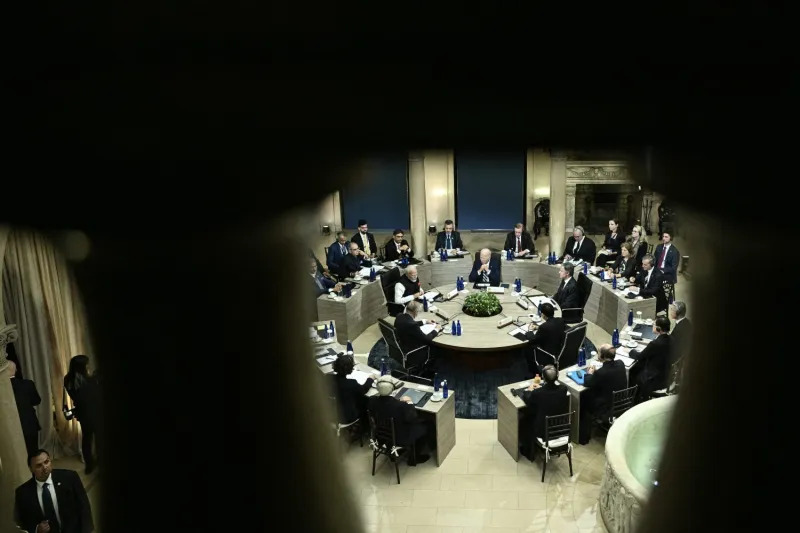(Source:China US Focus,2024-12-20)

U.S. President Joe Biden meets with Indian Prime Minister Narendra Modi, Australian Prime Minister Anthony Albanese, Japanese Prime Minister Fumio Kishida, and U.S. Secretary of State Antony Blinken during a Quad summit in Wilmington, Delaware, on Sept. 21. Brendan Smialkowski/AFP via Getty Images
During the presidential campaign in the United States, both Kamala Harris and Donald Trump have advocated strategic competition with China as a feature of their foreign policies. Whoever wins the election will inevitably continue with Washington’s Indo-Pacific strategy, the core of which is the Quadrilateral Security Dialogue, or Quad, comprising the U.S., Japan, Australia and India.
The consolidation of the Quad largely derives from Washington’s great power competition with China. In the Indo-Pacific strategic arrangement, the Quad is the skeleton of an alliance/partnership system characterized by a “big security” perspective that is designed to pressure China.
The concept of this quadrilateral mechanism initially came from Japan. Back in December 2012, the Japanese prime minister, Shinzo Abe, wrote about creating a “democratic security diamond,” at the core of which would be the United States, Japan, India and Australia, with the United Kingdom and France playing a bigger role. Short for the region spanning the Indian and Pacific oceans, the term “Indo-Pacific” embodies the idea of countering China’s rise. In November 2017, Donald Trump’s administration rolled out the concept of a “free and open Indo-Pacific.” During Trump’s tenure, the grouping was reactivated, quickly developing from a directorial-level coordinating platform for policy to the ministerial level.
U.S. President Joe Biden, who was inaugurated in January 2021, upgraded the Quad to a head-of-state mechanism. Although U.S. National Security Adviser Jake Sullivan has denied that the group amounts to an “Asian NATO,” its official full name — the Quadrilateral Security Dialogue — pretty much captures its fundamental nature.
The United States has been seeking to deal with long-term competition against China and other rivals by reshaping its alliance system. We can see from this quadrilateral mechanism that the U.S. is reinforcing its policy coordination and integration with its treaty allies and partners to construct a flexible alliance/partnership system. On top of joint military exercises, the four Quad countries are also collaborating more closely on economic security, maritime security, public health security, critical and emerging technologies, cyber security, semiconductor supply chains and outer space.
Through this process, America’s perception of a “China threat” — and measures to contain it — could become, step by step, a multilateral framework that influences the whole U.S. alliance-partnership system. Washington defines China-U.S. competition as democracy vs authoritarianism, and U.S. Deputy Secretary of State Kurt Campbell has said the Quad was an arrangement among “four maritime democracies.”
According to Manjari Chatterjee Miller, a senior fellow at the Council on Foreign Relations, India is committed to positioning itself as the champion of the Global South, so its competitive relationship with China and the U.S. should offer immense support. Also, the U.S. is deepening its quasi-alliance with India. In particular, the two sides are trying to integrate their defense and military sectors.
Besides the Quad, Washington has created another bloc, known as the I2U2. Formed with India, Israel and the United Arab Emirates, it is focused on West Asia and the Middle East. India serves as the adhesive of the two quadrilateral mechanisms, and the military relationships between Japan, Australia and India — core allies of the U.S. — have seen clear progress.
In September, President Biden hosted his final Quad summit at his Delaware home with the intent of leaving a political legacy. During the closed-door discussions, U.S. Secretary of State Antony Blinken announced the first topic: China. Members of Congress had already announced a bipartisan, bicameral Quad caucus, indicating that Congress attaches enormous importance to the Quad. Substantial outcomes were achieved at the summit in a range of areas, from security to economy, public health and infrastructure.
First, the four Quad countries agreed to push forward the Indo-Pacific Partnership for Maritime Domain Awareness, which aims at improving their capacity to monitor their waters and gather related intelligence. They also announced the launch of the Maritime Initiative for Training in the Indo-Pacific, with the idea that they would layer new technology and data into the IPMDA. In addition, the U.S. Coast Guard, Japan Coast Guard, Australian Border Force and Indian Coast Guard planned to launch a “Quad-at-Sea Ship Observation Mission” next year to improve interoperability and maritime safety.
Second, the Quad countries committed to strengthening infrastructure cooperation. They have invested more than $48 billion in infrastructure financing in the region since 2015, carrying out thousands of projects involving renewable energy, telecommunications, roads and water resources across more than 30 countries.
At the summit, the four nations announced the “Ports of the Future Partnership” initiative to support sustainable and resilient port infrastructure across the Indo-Pacific using the Quad’s expertise in collaboration with regional partners. They also released their “Principles for Development and Deployment of Digital Public Infrastructure” on top of the Quad infrastructure fellowship announced last year. Moreover, a logistics network pilot project “Quad Indo-Pacific Logistics Network” was launched, aiming to leverage their collective logistical strengths by promoting shared airlift capacity.
Third, the four nations are creating a “tech camp.” The Biden administration views competition in technology as the top priority in the China-U.S. rivalry, with tech playing an increasingly important role in Washington-dominated “minilateralism.” In this quadrilateral partnership, securing critical and emerging technologies is at the top of the agenda.
At the summit, the leaders also proposed further cooperation in artificial intelligence and launched two Track 1.5 dialogues — on AI and advanced communications technologies. In addition, they announced plans to launch what’s called the “BioExplore Initiative” to develop outer space technology, expand the Open Radio Access Network and collaborate on 5G.
The U.S. government values the role of social forces in the quadrilateral grouping. For instance, the Quad Fellowship, which is aimed at cultivating STEM talent, is led by the Institute of International Education and supported by private sector investors such as Google, the Pratt Foundation and Western Digital. In tech competition, the Quad is accelerating collaboration between companies, venture capital institutions, universities and research institutions in developing renewable energy, cybersecurity, aerospace and other sectors.
In conclusion, the Quad has become the primary priority in Washington’s Indo-Pacific strategy, and the new U.S. government after the election will likely continue with the alliance-partnership system against China. The Quad leaders’ summit in 2025 will be held in India.
Meanwhile, the challenges brought about by the increasing institutionalization of the Quad pose a test for Chinese diplomacy. Considering the evolution of such minilateral mechanisms involving several groups of players — U.S.-Japan-Australia, U.S.-Japan-Philippines and U.S.-UK-Australia — China has every reason to worry that camp confrontation, typical of the Cold War era, will only get worse. As the Ukraine war and conflicts in the Middle East continue unabated, Beijing and Washington should make joint efforts to prevent new military hot spots from igniting in the Asia-Pacific. Building a camp as exclusive as the Quad will only exacerbate the region’s security dilemma.






